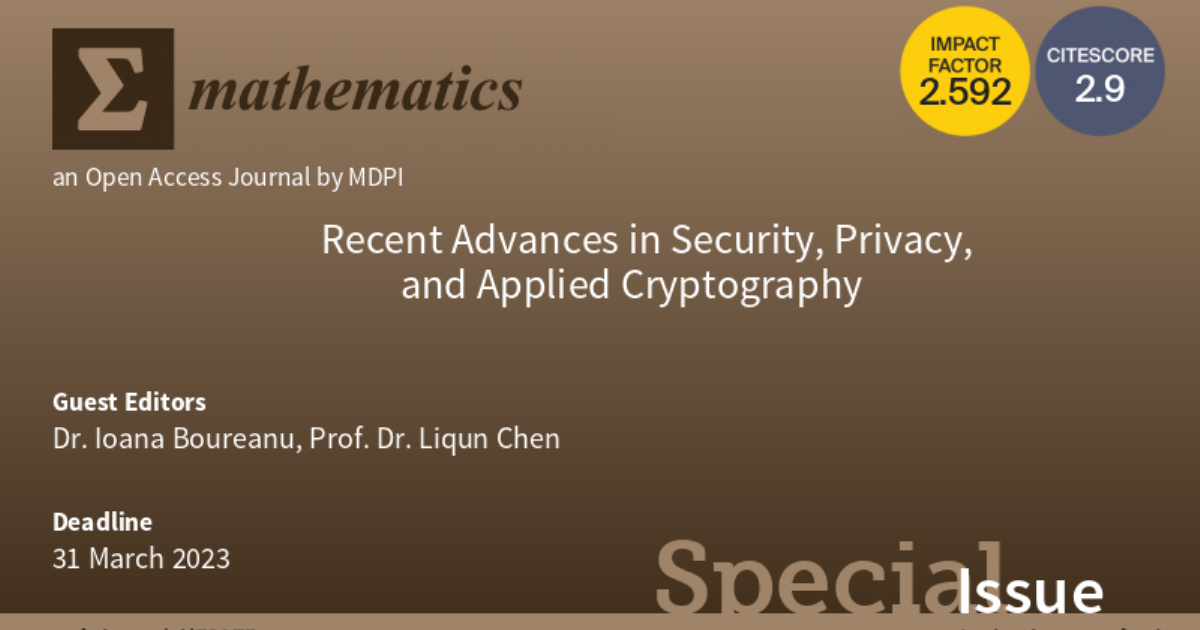Recent Advances in Security, Privacy, and Applied Cryptography
A special issue of Mathematics (ISSN 2227-7390). This special issue belongs to the section "E1: Mathematics and Computer Science".
Deadline for manuscript submissions: closed (31 March 2023) | Viewed by 67020

Special Issue Editors
Interests: applied cryptography; formal analysis of security and privacy
Special Issues, Collections and Topics in MDPI journals
Interests: post-quantum cryptography; anonymity
Special Issues, Collections and Topics in MDPI journals
Special Issue Information
Dear Colleagues,
In the last decade, the mathematics behind security and privacy has seen great advances both in theories and in applications, e.g., new formal models to support blockchains, new flavours of zero-knowledge to fuel cryptocurrencies, and a boost in privacy research of various kinds driven by contact-tracing applications. In this Special Issue, we are particularly looking for your submissions on the mathematical foundations of these timely matters of security and privacy, which have sparked our interest via the recent technological and ICT trends. However, we do not wish to restrict the Special Issue to these particular use cases, but rather encourage submissions, specifically on foundational aspects, on all that may constitute recent matters of security and privacy.
Assoc. Prof. Ioana Boureanu
Prof. Dr. Liqun Chen
Guest Editors
Manuscript Submission Information
Manuscripts should be submitted online at www.mdpi.com by registering and logging in to this website. Once you are registered, click here to go to the submission form. Manuscripts can be submitted until the deadline. All submissions that pass pre-check are peer-reviewed. Accepted papers will be published continuously in the journal (as soon as accepted) and will be listed together on the special issue website. Research articles, review articles as well as short communications are invited. For planned papers, a title and short abstract (about 100 words) can be sent to the Editorial Office for announcement on this website.
Submitted manuscripts should not have been published previously, nor be under consideration for publication elsewhere (except conference proceedings papers). All manuscripts are thoroughly refereed through a single-blind peer-review process. A guide for authors and other relevant information for submission of manuscripts is available on the Instructions for Authors page. Mathematics is an international peer-reviewed open access semimonthly journal published by MDPI.
Please visit the Instructions for Authors page before submitting a manuscript. The Article Processing Charge (APC) for publication in this open access journal is 2600 CHF (Swiss Francs). Submitted papers should be well formatted and use good English. Authors may use MDPI's English editing service prior to publication or during author revisions.
Keywords
- Anonymity
- Application security
- Applied cryptography
- Attacks and defences
- Attestation
- Authentication
- Blockchains and distributed ledger security
- Cloud security
- Cyber physical systems security
- Distributed systems security
- Economics of security and privacy
- Embedded systems security
- Forensics
- Hardware security
- Intrusion detection and prevention
- Mobile and web security and privacy
- Machine learning and AI security
- Network and systems security
- Privacy technologies and mechanisms
- Privacy formalisms
- Protocol security
- Secure information flow
- Security and privacy for the Internet of Things
- Security and privacy metrics
- Security and privacy policies
- Security architectures
- Usable security and privacy
- Trustworthy computing
- Web security
Benefits of Publishing in a Special Issue
- Ease of navigation: Grouping papers by topic helps scholars navigate broad scope journals more efficiently.
- Greater discoverability: Special Issues support the reach and impact of scientific research. Articles in Special Issues are more discoverable and cited more frequently.
- Expansion of research network: Special Issues facilitate connections among authors, fostering scientific collaborations.
- External promotion: Articles in Special Issues are often promoted through the journal's social media, increasing their visibility.
- e-Book format: Special Issues with more than 10 articles can be published as dedicated e-books, ensuring wide and rapid dissemination.
Further information on MDPI's Special Issue polices can be found here.





